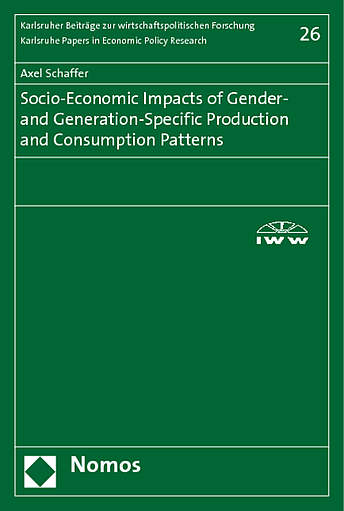englischThe study identifies, in a first step, gender- and age-specific production patterns. The combination of time use data, input-output analysis and material balances allows for the simultaneous consideration of women’s and men’s working time and their contributions to GDP, household production and CO2 emissions.
The second step foresees the gender- and age-specific analysis of the demand side. Therefore the model separates women’s and men’s consumption of market and non-market goods and services.
The identification of genders’ production and consumption patterns enables, in a third step, the modelling of gender-linkages. Thus, the study shows, for example, to which extent women benefit from women’s or men’s work.
While men’s role is strong regarding highly acknowledged paid work, the provision of private non-market services heavily relies on women’s work. To balance the distribution of work, the study finally introduces the concept of a Desired World which accounts for a desired reduction of paid working time and foresees a higher recognition of unpaid work. Thus, women’s role with regard to paid work and men’s participation in the field of unpaid work could be strengthened.
Die Arbeit identifiziert zunächst geschlechtsspezifische Produktionsmuster. Durch die Kombination von Zeitverwendungsdaten mit Input-Output-Tabellen und Materialbilanzen lassen sich die branchenbezogenen Outputs in Stunden und CO2 Emissionen sowie der Beitrag von Frauen und Männern zum Bruttoinlandsprodukt ermitteln. Die Ergebnisse der Satellitenrechnung zur Haushaltsproduktion ermöglichen zudem eine Zuordnung der Stunden bzw. unterstellten Werte der unbezahlten Arbeit nach Geschlecht.
Durch die Identifikation geschlechtsspezifischer Konsummuster, in die der Konsum marktlicher und nicht-marktlicher Güter und Dienste eingeht, lässt sich in einem weiteren Schritt eine Verflechtungsmatrix zwischen den Geschlechtern modellieren. Diese beschreibt inwieweit z.B. Männer von beruflichen und unbezahlten Arbeiten der Frauen bzw. ihrer Geschlechtsgenossen profitieren.
Die Ergebnisse zeigen eine ungleiche Verteilung der Arbeit. Durch eine Reduzierung der Erwerbsarbeitszeit und Aufwertung unbezahlter Arbeiten, wie sie das abschließend vorgestellte Konzept der Desired World postuliert, ließen sich die Rolle der Frauen in der beruflichen und die Rolle der Männer in der unbezahlten Arbeit stärken.


